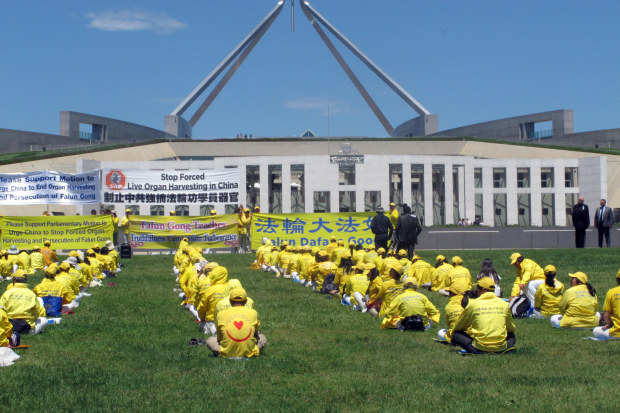Surgeons executed Chinese prisoners for organs, says ANU study

Tokyo | A new Australian study says it has unearthed evidence that surgeons in China have harvested the hearts of death row prisoners before they were medically brain-dead.
The Australian National University study published in the American Journal of Transplantation on Tuesday examined thousands of Chinese medical papers published over decades to argue that surgeons were enlisted by the state to kill prisoners using organ transplant surgery.

Falun Gong practitioners demonstrate outside Parliament House in Canberra in 2016 over organ harvesting claims. AP
While official Chinese records state that the prisoners were brain-dead before the organs were removed, the study’s researchers said their computer modelling uncovered proof that was not the case.
In 2015, China said it had stopped harvesting the organs of executed prisoners, which human rights groups have said also included persecuted minority groups such as the Falun Gong and Uighur Muslims.
However, this is the first systematic study suggesting that prisoners were still alive on the operating table in Chinese state and military hospitals when their hearts and lungs were removed. Those findings argued surgeons were acting as executioners rather than the firing squads, in a breach of global medical ethics.
“We found that the physicians became the executioners on behalf of the state, and that the method of execution was heart removal,” study co-author and PhD researcher Matthew Robertson said.
“These surgeries are highly profitable for the doctors and hospitals that engage in them.”
‘There are probably a lot more hidden’
The study used computational text analysis to conduct a forensic review of 2838 papers drawn from a dataset of 124,770 Chinese-language transplant publications. An algorithm searching for evidence of problematic declarations of brain death found evidence in 71 of the reports that brain death was not declared properly.
That meant the removal of the heart during the procedure was the medical cause of death, making the surgeons themselves the executioners.
Mr Robertson told The Australian Financial Review it was likely the numbers were much higher than 71 given the evidence was taken from a small sample, inconclusive results were omitted, and 56 hospitals and more than 300 medical workers in China were found to be involved.
“There are probably a lot more hidden. This is taken from a small sample,” he said.
Dr Jacob Lavee, an Israeli cardiac transplant surgeon, who also has an affiliation with Tel Aviv University, is a co-author of the paper.
Mr Robertson said the surgeries were conducted on death-row prisoners and on “prisoners of conscience”, which could include political prisoners or ethnic Uighurs.
“While we don’t know exactly how these prisoners end up on the operating table, we can speculate there are multiple troubling scenarios as to how this happens,” Mr Robertson said.
“These include a bullet to the prisoner’s head before being immediately rushed to hospital, or a drug injection that paralyses the prisoner.”
It was unclear if any of the prisoners were conscious during the organ removal process, although that was not the focus of the study.
The global dead-donor rule states that organ procurement must not begin until a donor is formally pronounced dead.
The data that was collected scrutinised the clinical procedures around intubation and ventilation of donors, declaration of brain death, and the start of organ procurement surgery
Mr Robertson also co-authored a 2019 paper suggesting the Chinese government might have used a simple mathematical equation to falsify its voluntary organ donation numbers.
China has repeatedly denied allegations it engages in organ harvesting. However, it has what is believed to be the world’s largest voluntary organ donation program.

No comments:
Post a Comment